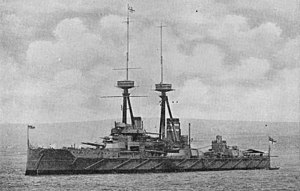
Back HMS St Vincent (1908) German HMS St. Vincent (1908) Spanish اچاماس سنت وینسنت (۱۹۰۸) Persian HMS St. Vincent (1908) Finnish HMS St. Vincent (1908) French אה"מ סנט וינסנט (1908) HE HMS St Vincent (1908) Italian セント・ヴィンセント (戦艦) Japanese HMS «St. Vincent» (1908) NB HMS St Vincent (1908) Portuguese
 St Vincent at the Coronation Review, Spithead, 24 June 1911
| |
| History | |
|---|---|
| Name | St Vincent |
| Namesake | Admiral of the Fleet John Jervis, Earl of St Vincent |
| Ordered | 26 October 1907 |
| Builder | HM Dockyard, Portsmouth |
| Laid down | 30 December 1907 |
| Launched | 10 September 1908 |
| Completed | May 1909 |
| Commissioned | 3 May 1910 |
| Decommissioned | March 1921 |
| Fate | Sold for scrap, 1 December 1921 |
| General characteristics (as built) | |
| Class and type | St Vincent-class dreadnought battleship |
| Displacement | 19,700 long tons (20,000 t) (normal) |
| Length | 536 ft (163.4 m) (o/a) |
| Beam | 84 ft (25.6 m) |
| Draught | 28 ft (8.5 m) |
| Installed power |
|
| Propulsion | 4 × shafts; 2 × steam turbine sets |
| Speed | 21 knots (39 km/h; 24 mph) |
| Range | 6,900 nmi (12,800 km; 7,900 mi) at 10 knots (19 km/h; 12 mph) |
| Complement | 756–835 |
| Armament |
|
| Armour | |
HMS St Vincent was the lead ship of her class of three dreadnought battleships built for the Royal Navy in the first decade of the 20th century. After commissioning in 1910, she spent her whole career assigned to the Home and Grand Fleets, often serving as a flagship. Aside from participating in the Battle of Jutland in May 1916, during which she damaged a German battlecruiser, and the inconclusive action of 19 August several months later, her service during World War I generally consisted of routine patrols and training in the North Sea. The ship was deemed obsolete after the war and was reduced to reserve and used as a training ship. St Vincent was sold for scrap in 1921 and broken up the following year.